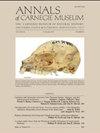New Genus and Species of Djadochtatheriid Multituberculate (Allotheria, Mammalia) from the Upper Cretaceous Bayan Mandahu Formation of Inner Mongolia
IF 0.9
4区 地球科学
Q4 PALEONTOLOGY
引用次数: 9
Abstract
ABSTRACT The superfamily Djadochtatherioidea is a distinctive clade of multituberculates from Upper Cretaceous beds of Mongolia and Inner Mongolia, China. Because many of the 11 included genera are known from skulls, more is known about the cranial anatomy of djadochtatherioids than any other clade of multituberculates. Within Djadochtatherioidea, the most diverse and widely accepted group is the family Djadochtatheriidae. Within the family, the basal genus, Kryptobaatar Kielan-Jaworowska, 1970, is small with a skull length of about 30 mm, whereas the other four genera, Djadochtatherium Simpson, 1925, Catopsbaatar Kielan-Jaworowska, 1994, Tombaatar Rougier et al., 1997, and Mangasbaatar Rougier et al., 2016, have skulls approximately twice as long. Here, we describe a new genus and species, Guibaatar castellanus, based on a single specimen from the Upper Cretaceous Bayan Mandahu Formation, Inner Mongolia that we refer to Djadochtatheriidae. Guibaatar is represented by a relatively complete rostrum, a partial right braincase, and partial lower jaws. As revealed by CT scanning, the specimen is a juvenile, with deciduous enlarged upper and lower incisors with permanent replacements forming, m2 erupting, and M2 forming. Based on the preserved cranial parts, we estimate the skull length to be approximately 50 mm, but as an adult, Guibaatar would have been in the size range of the larger djadochtatheriids. Phylogenetic analysis including Guibaatar, known djadochtatherioids, and outgroups places Guibaatar within Djadochtatheriidae, as sister to a clade of Mangasbaatar and Catopsbaatar. We suspect the relationships of djadochtatherioids are likely to be refined given the announcements by other researchers that skulls are known for the djadochtatheriids Tombaatar and Djadochtatherium, which were previously represented by incomplete material.内蒙古上白垩世巴颜曼达湖组多结核Djadochtatheriid Multituberculate(异源兽目,哺乳纲)新属新种
Djadochtatherioidea超科是蒙古和内蒙古上白垩统多瘤类的一个独特分支。因为这11个属中的许多都是从头骨中发现的,所以人们对djadochtatheriids的颅骨解剖结构的了解比任何其他多瘤动物的分支都要多。在djadochtatheriidea中,最多样化和被广泛接受的群体是Djadochtatheriidae家族。在该科中,基属Kryptobaatar Kielan-Jaworowska(1970)很小,头骨长度约为30毫米,而其他四个属,Djadochtatherium Simpson(1925)、Catopsbaatar Kielan-Jaworowska(1994)、Tombaatar Rougier等人(1997)和Mangasbaatar Rougier等人(2016)的头骨长度约为基属的两倍。本文基于内蒙古上白垩统巴彦曼达湖组的单一标本,描述了一个新的属和种——Guibaatar castellanus,我们称之为Djadochtatheriidae。gubaatar的代表是一个相对完整的讲台,部分右脑和部分下颚。CT扫描显示,标本为幼年,乳白色上、下切牙肿大,形成永久性替代物,m2出牙,m2形成。根据保存下来的颅骨部分,我们估计其颅骨长度约为50毫米,但作为一个成年人,Guibaatar的大小应该在较大的djadochtatheriids的范围内。系统发育分析包括Guibaatar,已知的djadochtatheriids,和外群将Guibaatar归入Djadochtatheriidae,是Mangasbaatar和Catopsbaatar的一个分支的姐妹。我们怀疑,鉴于其他研究人员的声明,已知的头骨是djadochtatheriids Tombaatar和Djadochtatherium,它们以前是由不完整的材料代表的,因此djadochtatheriids的关系可能会得到改进。
本文章由计算机程序翻译,如有差异,请以英文原文为准。
求助全文
约1分钟内获得全文
求助全文
来源期刊

Annals of Carnegie Museum
综合性期刊-动物学
CiteScore
2.50
自引率
18.20%
发文量
4
审稿时长
>12 weeks
期刊介绍:
Annals of Carnegie Museum is a quarterly journal that publishes peer-reviewed short and medium-length original scientific contributions in organismal biology, earth sciences, and anthropology, in 40 by 52.5 pica format (168 by 220 mm or 6-5/8 by 8-5/8 inches). Subject matter must be relevant to Carnegie Museum of Natural History scientific sections or Powdermill Nature Reserve (PNR), preferably with connection to the Carnegie collection and/or personnel. Carnegie Museum staff and research associates receive publication priority, but others are encouraged to submit papers, especially those manuscripts explicitly based on the Carnegie collection.
 求助内容:
求助内容: 应助结果提醒方式:
应助结果提醒方式:


